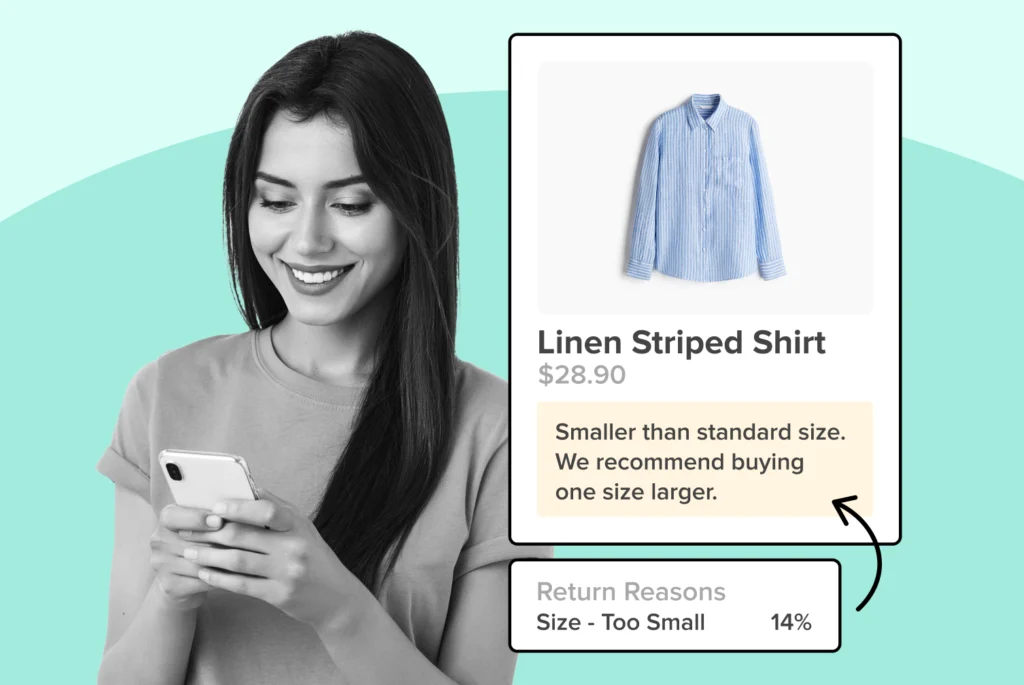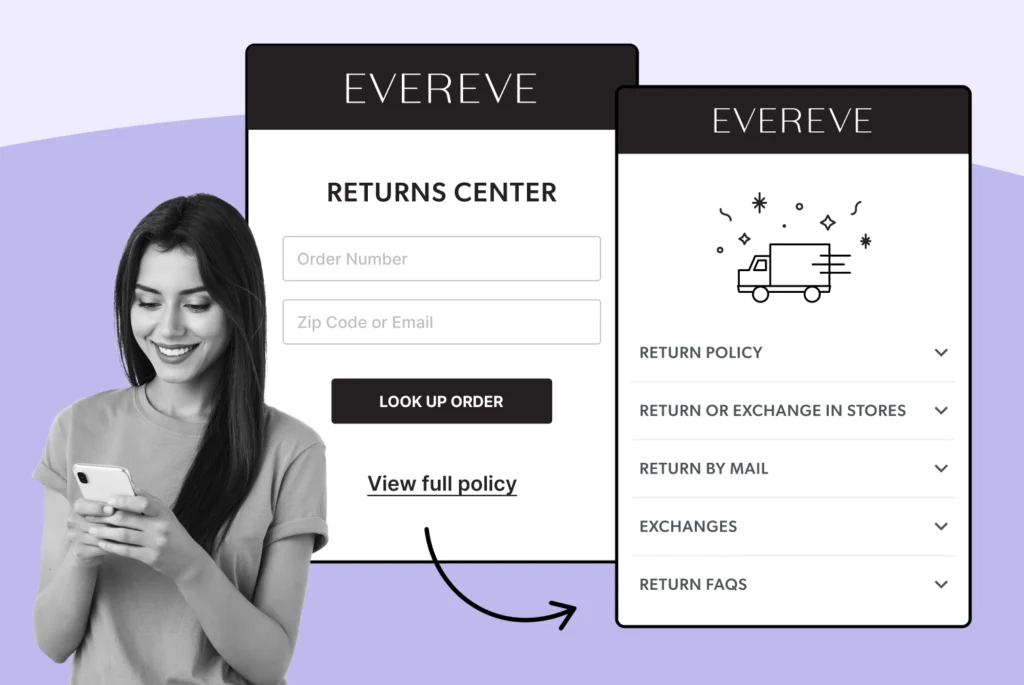
How to Use Sizing Online to Reduce Returns: Proven Communication Tips
Learn effective communication strategies to improve sizing accuracy and reduce returns. Discover practical tips to enhance your online shopping experience.
Shipping, Tracking & Notifications
Boost customer experience and reduce support tickets
Realtime order and shipment tracking
Proactive order and shipping notifications
AI-Enhanced Discounted Labels
Predictive pre-purchase estimated delivery dates
Self-Serivce branded order tracking
Effortless experience delivered
Identify and Resolve Order Issues
Realtime order and shipment tracking
Make returns profitable and delight customers
Flexibility to define any return destinations & conditions
Simplify returns for your customers and team
Incentivize exchanges over returns
Returns management made easy for your team
Returns management made easy for your team
Easy claims and smart upsells
Understand why your customers are returning
In-Store & Curbside Pickup
Unify the online and the in-store experience
Hassle-free pickup experience for customers
In-Store dashboard to keep operations streamlined
In-Store and Online orders unified
Drive foot-traffic to your stores
Shipping, Tracking & Notifications
Boost customer experience and reduce support tickets
Realtime order and shipment tracking
Proactive order and shipping notifications
AI-Enhanced Discounted Labels
Predictive pre-purchase estimated delivery dates
Self-Serivce branded order tracking
Effortless experience delivered
Identify and Resolve Order Issues
Realtime order and shipment tracking
Make returns profitable and delight customers
Flexibility to define any return destinations & conditions
Simplify returns for your customers and team
Incentivize exchanges over returns
Returns management made easy for your team
Returns management made easy for your team
Understand why your customers are returning
In-Store & Curbside Pickup
Unify the online and the in-store experience
Hassle-free pickup experience for customers
In-Store Dashboard to keep operations streamlined
In-Store and Online orders unified
Drive foot-traffic to your stores
Boost customer experience and reduce support tickets
Realtime order and shipment tracking
Proactive order and shipping notifications
AI-Enhanced Discounted Labels
Predictive pre-purchase estimated delivery dates
Self-Serivce branded order tracking
Effortless experience delivered
Make returns profitable and delight customers
Flexibility to define any return destinations & conditions
Simplify returns for your customers and team
Incentivize exchanges over returns
Returns management made easy for your team
Equip your team for precise return checks.
Easy claims and smart upsells
Understand why your customers are returning
Unify the online and the in-store experience
Hassle-free pickup experience for customers
In-Store Dashboard to keep operations streamlined
In-Store and Online orders unified
Drive foot-traffic to your stores
Find the answer to all your questions
Take a step by step trip through our functionality to see how we can improve your ecommerce processes.
Explore the most comon questions about WeSupply
Calculate the ROI that WeSupply can bring you
Read actionable articles on how to optimize your post-purchase experience and decrease support tickets
Get inspired by stories of how our customers implemented an effortless post-purchase experience
Wondering if WeSupply is a good fit for you? Read through our use cases to see how we can help you increase conversion & improve CX!
A Deep Dive into Top Companies' Order Tracking & Returns Strategy
Find the answer to all your questions
Explore the most comon questions about WeSupply
Calculate the ROI that WeSupply can bring you
Request a no strings attached review of your current shopping experience and missed conversion opportunities
Take a step by step trip through our functionality to see how we can improve your ecommerce processes.
Read actionable articles on how to optimize your post-purchase experience and decrease support tickets
Get inspired by stories of how our customers implemented an effortless post-purchase experience
A Deep Dive into Top Companies' Order Tracking & Returns Strategy
Wondering if WeSupply is a good fit for you? Read through our use cases to see how we can help you increase conversion & improve CX!

In the competitive world of eCommerce and product development, high return rates can damage profitability and customer trust. Preparing for a big product launch is crucial, as it requires the right mindset and strategies to ensure success. One of the most effective strategies to combat this issue is pre-launch failure analysis. This proactive process identifies potential quality issues and production errors before a product ever reaches the customer, significantly reducing the likelihood of costly returns.
In this article, we’ll explore how pre-launch failure analysis helps prevent returns, boosts product quality, aligns with customer expectations, and ensures compliance with industry standards. We’ll also cover related strategies such as market research, customer feedback, quality assurance, and success metrics that contribute to a smooth and profitable product launch.
Pre-launch failure analysis is a systematic evaluation process conducted during product development. It aims to detect design flaws, material defects, and production errors before a product reaches the market. This method is commonly used in industries such as automotive, electronics, and eCommerce, where product quality directly impacts customer satisfaction and return rates.
Sales teams play a crucial role in pre-launch failure analysis by providing valuable insights from their direct interactions with customers. Their involvement in the product development process helps identify potential issues that may not be apparent to the development team, ensuring a more comprehensive evaluation.
By identifying and correcting potential problems early, brands can avoid shipping defective or subpar products. This not only saves money on returns and recalls but also preserves brand reputation and customer loyalty.
Return management costs can eat into profit margins, especially for eCommerce retailers. The reasons behind returns are often related to product quality, misaligned customer expectations, or non-compliance with regulatory standards. Addressing these issues before launch can dramatically reduce return rates.
Customer dissatisfaction due to product quality issues can lead to high return rates and significantly impact profitability.
Returns don’t just hurt financially—they also impact logistics, inventory control, and customer trust. Preventing returns through pre-launch analysis means more satisfied customers, streamlined operations, and higher profit margins.
Understanding the market is the foundation of a successful launch. Thorough market research is crucial as it provides deep insights into customer preferences, expectations, and pain points, helping to prevent returns and inform marketing decisions.
Identifies gaps in the market.
Validates product-market fit by determining which product versions or strategies resonate more with the audience.
Provides competitive analysis.
Guides pricing and feature decisions.
Surveys, interviews, focus groups, and competitor benchmarking all contribute to building a clear picture of what customers want. A well-informed product development process leads to better outcomes and reduces the likelihood of mismatched expectations—one of the top reasons for product returns.
Customer feedback, especially direct feedback, is essential before launch. Whether it’s through beta testing, product sampling, or online reviews of similar products, feedback highlights weaknesses that internal teams might overlook.
Feature gaps or design flaws.
Misunderstood instructions or interfaces.
Usability concerns.
Incorporating this feedback into the development cycle increases customer satisfaction post-launch and helps reduce return requests caused by product disappointment.
A detailed launch plan is more than a timeline—it’s a strategic guide that outlines each phase of the pre-launch process. This includes development, testing, quality control, marketing, and post-launch support.
Define responsibilities and timelines.
Identify checkpoints for testing and compliance.
Include contingency plans for potential failures.
By forecasting potential roadblocks and setting mitigation strategies, companies can avoid last-minute surprises that lead to poor launches and high return volumes.
Pre-launch testing is the cornerstone of failure analysis, and thorough testing is crucial in this phase. It includes prototype testing, user acceptance testing (UAT), and quality assurance protocols. This ensures that only products that meet stringent standards make it to customers.
Detects design or material flaws.
Verifies functionality and durability.
Ensures consistent performance.
For example, in the automotive industry, companies use Pre-Launch Control Plans as required by IATF 16949 standards to catch issues during trial runs. Similar processes can be adopted across industries to prevent product returns due to manufacturing defects or compliance failures.
Many industries have strict compliance regulations, especially in automotive, electronics, food, and healthcare. Failing to meet these standards can result in legal issues, recalls, and high return rates.
Effective risk management is crucial in ensuring compliance and preventing returns. By identifying potential risks and implementing effective planning strategies, teams can significantly enhance their chances of a successful launch and mitigate anxiety associated with uncertainties.
Confirms that materials and processes meet regulatory standards.
Validates against customer-specific requirements (e.g., Ford’s Trial Tooling, GM’s Early Production Containment).
Involves checklists, documentation, and compliance audits.
When compliance is baked into the pre-launch process, companies are less likely to receive returns due to unmet safety, quality, or performance expectations.
Some of the most frequent product launch mistakes include:
Rushing the launch without proper testing.
Ignoring user feedback.
Underestimating production limitations.
Inadequate staff training or customer support.
Negative reviews can arise from these common mistakes, leading to customer dissatisfaction and harming a product’s reputation.
Pre-launch failure analysis, when combined with proper planning and market research, helps companies avoid these common pitfalls. The result? Fewer product malfunctions and lower return rates.
Return rates can spike when customers feel misled by product descriptions or marketing campaigns. That’s why a well-crafted and honest marketing message is vital.
Email marketing plays a crucial role in setting realistic expectations and generating excitement for the product, especially when used alongside social media and influencer collaborations.
Email marketing plays a crucial role in setting realistic expectations and generating excitement for the product, especially when used alongside social media and influencer collaborations.
Reflect actual product capabilities.
Align visuals with real-world use.
Highlight differentiators clearly.
This prevents “expectation gaps” that often lead to return requests. By setting realistic expectations, brands earn trust and reduce the likelihood of buyer’s remorse.
Even the best products can be returned if the service experience is poor. A well-prepared customer support team is essential for:
Troubleshooting issues quickly.
Offering guidance on usage.
Reducing frustration through empathy and resolution.
With support agents trained pre-launch, companies can handle concerns before they turn into returns, improving retention and satisfaction.
No product launch goes 100% as planned. That’s why flexibility and scalability must be built into the process. Whether it’s tweaking production volumes or updating support documentation in response to early feedback, agile companies can reduce damage from launch issues.
Flexibility and scalability are also crucial for achieving long term success, as they allow for continuous improvement based on customer feedback and performance monitoring.
Improve inventory flow.
Reduce delays.
Fix defects quickly.
Lower potential return risks.
Conducting a post-launch review and analysis is essential for understanding the success of a product launch and identifying areas for improvement. This review involves gathering data on sales, customer feedback, and market trends to gain a comprehensive understanding of the launch outcomes.
Simplify Returns for Your Customers and Support Team
Book a quick call with our experts to see how WeSupply can help you: simplify the Return experience with just a few clicks, reduce customer service calls and manual processing, notify your customer about their refund, automate returns and reduce user error.
WeSupply, a returns management platform, doesn’t have a specific tool named “Pre-Launch Failure Analysis,” but it supports preventing returns through its returns analytics feature. This feature provides detailed insights into why products are returned, such as sizing issues or quality defects, which businesses can use to improve future products before they launch.
WeSupply’s analytics allow businesses to analyze return data at the SKU level, identifying common return reasons like color, quality, or size. By understanding these patterns, companies can adjust sizing charts, enhance product images, and gather customer feedback to refine product fit, all before launching new items.
The data from returns analytics can inform pre-launch strategies, helping businesses address potential issues. For example, if a product size is frequently returned, the business can update sizing guides or work with manufacturers to improve quality, reducing the likelihood of returns for similar future products.
WeSupply is designed as an end-to-end post-purchase experience platform, focusing on automating returns, improving customer engagement, and preventing fraudulent returns. Its integration with eCommerce and logistics platforms, such as Shopify and Magento, makes it a scalable solution for businesses of all sizes. While the platform primarily addresses post-purchase processes, its analytics tools provide a foundation for proactive strategies that can prevent returns before they occur.
WeSupply’s returns analytics is an essential feature that helps businesses dive deep into return patterns, allowing for strategic improvements and reducing future return rates. Here’s how it works:
Sizing Chart Adjustments: Helps businesses modify sizing guides based on frequent returns caused by fit issues, enhancing accuracy and customer satisfaction.
Product Image Review: Analyzes return data to evaluate and improve product images, ensuring they accurately represent the product to reduce expectation gaps.
Customer Feedback Collection: Gathers insights on product fit and performance, allowing brands to enhance future designs based on real customer experiences.
Identifying High-Return Products: Pinpoints products that may require more reviews, improved descriptions, or quality adjustments to lower return rates.
Financial Impact Analysis: Measures revenue loss and costs associated with returns, helping businesses develop more cost-effective return management strategies.
These analytics empower businesses to understand customer return behaviors, which is essential for informed decision-making as they scale. For instance, if a particular product variant, such as a specific color, is frequently returned, the business can investigate whether the color representation in images is misleading or if there are quality issues, and address these before launching similar products.
The insights from WeSupply’s returns analytics can be directly applied to pre-launch strategies, effectively serving as a form of “Pre-Launch Failure Analysis.” Here are specific ways businesses can use this data:
Improving Product Quality: By identifying quality defects through returns data, businesses can work with manufacturers to enhance production standards before launching new products, reducing the likelihood of returns due to defects.
Enhancing Product Descriptions and Images: Return analytics can reveal if customers return products due to mismatched expectations (e.g., color or functionality). Businesses can then refine product descriptions and images to align with customer perceptions, minimizing returns for future launches.
Gathering Customer Feedback: WeSupply’s platform allows businesses to collect feedback during the returns process, which can inform product development. For example, if customers frequently mention discomfort with a product, this feedback can be used to redesign future iterations before launch.
The effectiveness of using returns data for pre-launch improvements is supported by examples. For instance, the case study of Evereve, an eCommerce brand, leveraged WeSupply’s analytics to understand return patterns, optimizing inventory and reducing future returns. This demonstrates how returns data can be transformed into actionable insights for product improvement, aligning with the goal of preventing returns.
Another example involves Humane, a brand dealing with complex bundled items. By integrating WeSupply, they streamlined returns and replacements, using data to improve the customer experience, which indirectly supports reducing returns for future launches by addressing operational inefficiencies.
Using returns data to prevent future returns also has financial and operational benefits. WeSupply’s analytics help businesses measure the financial impact of returns, such as revenue lost ($13.70 for every $100 in returns due to fraud) and costs associated with processing returns. By identifying process inefficiencies, businesses can optimize operations, reducing costs and retaining revenue through strategies like converting returns into exchanges, which can retain up to 48% of revenue from returned products (Returns Management: 10 Reasons to Choose WeSupply).
Combat inconvenience with proactivity & self service
Book a quick call with our experts to see how WeSupply can help you make returns easy for your customers with a beautiful, self-service solution that makes their experience easier while also providing new ways to lower costs and earn back revenue.
Beyond financial benefits, analyzing returns data supports sustainability by minimizing waste. WeSupply encourages strategies like incentivizing exchanges over refunds, which can reduce the environmental impact of returns while fostering customer loyalty. This aligns with customer expectations, as 72% of customers deem easy return policies crucial to their buying decisions, impacting loyalty and repeat business.
Pre-launch failure analysis is no longer optional—it’s essential. From preventing defective products and reducing return rates to ensuring compliance and improving customer satisfaction, this proactive approach sets the stage for long-term business success.
Continuously improving products based on customer feedback is crucial for maintaining and enhancing customer satisfaction post-launch. By investing in market research, pre-launch testing, quality assurance, and customer support preparation, companies can create a seamless launch experience. Most importantly, they can prevent returns that drain resources, damage reputations, and frustrate customers.
In summary, WeSupply helps prevent returns for future product launches by providing returns analytics that serve as a de facto “Pre-Launch Failure Analysis” tool. By identifying common return reasons and leveraging these insights, businesses can improve product quality, adjust sizing, enhance descriptions, and gather feedback before launching new items. This data-driven approach reduces the likelihood of returns, enhances customer satisfaction, and supports operational efficiency, aligning with the goal of minimizing returns through proactive strategies. Don’t just hope for fewer returns—plan for it. Book a demo today to see how WeSupply can support your pre-launch strategy!
Pre-launch failure analysis helps reduce return rates by determining and resolving potential product issues—such as design flaws, quality defects, or mismatched customer expectations—before the product reaches the market. This proactive approach ensures that only thoroughly tested and customer-aligned products are launched, significantly lowering the likelihood of returns due to dissatisfaction or malfunction.
Common pre-launch testing methods include beta testing, user acceptance testing (UAT), prototype testing, and quality assurance inspections. These methods help evaluate how the product performs under real-world conditions, gather user feedback, and detect any technical or usability issues before the official launch. This reduces the risk of post-purchase problems and product returns.
Absolutely. Even small eCommerce businesses can benefit from a simplified version of pre-launch failure analysis. Conducting market research, gathering early feedback through sample releases or focus groups, and performing basic quality checks can help small brands minimize costly returns. These steps also boost customer satisfaction and build a reputation for reliability and quality.
WeSupply’s returns analytics allow you to analyze historical return data to uncover why products were returned, such as sizing issues, quality defects, or mismatched customer expectations. By accessing the returns analytics dashboard, you can filter data by product, variant (e.g., size, color), or return reason (e.g., “defective,” “not as described”). This insight enables you to identify potential failure points in similar new products before they launch. For example, if past returns highlight frequent sizing complaints, you can adjust the design or provide clearer sizing guides, preventing similar returns for the new product.
WeSupply provides detailed, actionable data that supports pre-launch improvements, including:
SKU-level insights: Return reasons tied to specific product variants (e.g., a certain size or color).
Reason codes: Precise explanations for returns, such as “too small” or “poor quality.”
Customer feedback: Comments collected during the returns process, revealing issues like fit or satisfaction.
Using this data, businesses can refine product designs, enhance quality control, or update marketing materials to address these issues before launch, reducing the risk of returns.
WeSupply’s returns analytics enable businesses to proactively tackle issues identified in past returns, ensuring new products launch with fewer problems. For instance, if analytics show high return rates due to quality defects, you can tighten manufacturing standards. If returns stem from unclear product descriptions, you can improve images and details to match customer expectations. By addressing these failure points pre-launch, WeSupply helps increase customer satisfaction and minimize returns, contributing to a smoother, more successful product rollout.
Yes, WeSupply does have an official Shopify App. You can download and begin to integrate it with your Shopify store.
Yes, WeSupply has an official extension for Magento. The WeSupply x Magento integration allows for automating order tracking experiences, reducing customer inquiries, automating shipping email and SMS notifications, and providing a fully branded order tracking experience
Yes, WeSupply has an official BigCommerce App. You can integrate WeSupply with your BigCommerce store to improve your post-purchase customer experience.
Learn How To Create Successful Post Purchase Email Campaigns
Build an effective post-purchase email flow that helps you increase customer satisfaction and drive revenue growth!

Learn effective communication strategies to improve sizing accuracy and reduce returns. Discover practical tips to enhance your online shopping experience.

Explore the legal aspects of return policies and whether they constitute a legal agreement. Learn how this impacts your shopping experience. Read more.

Discover 5 effective strategies to enhance your product photos and minimize returns. Improve customer satisfaction and boost sales—read the article now!

Learn how to optimize packaging for hassle-free returns and exchanges. Enhance customer satisfaction and streamline your process. Read the guide now!

Discover effective strategies to reduce shipping delays and enhance your logistics. Improve efficiency and keep your operations running smoothly. Read more!

Discover the key traits that define today’s influencers and how they shape marketing strategies. Enhance your influencer approach!

Learn effective post-purchase email strategies to enhance customer loyalty and improve retention. Engage your customers today!

Discover thoughtful gifts for every mom this Mother’s Day. From practical to sentimental, find the perfect option to show your appreciation!

Discover the pros and cons of return labels for online shopping. Make informed decisions and streamline your returns. Read more for essential insights!